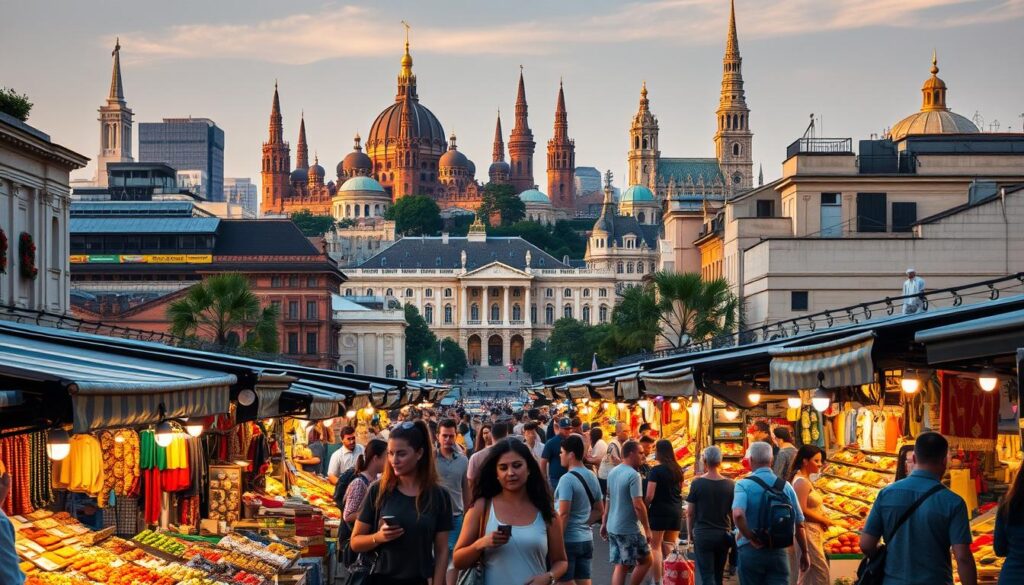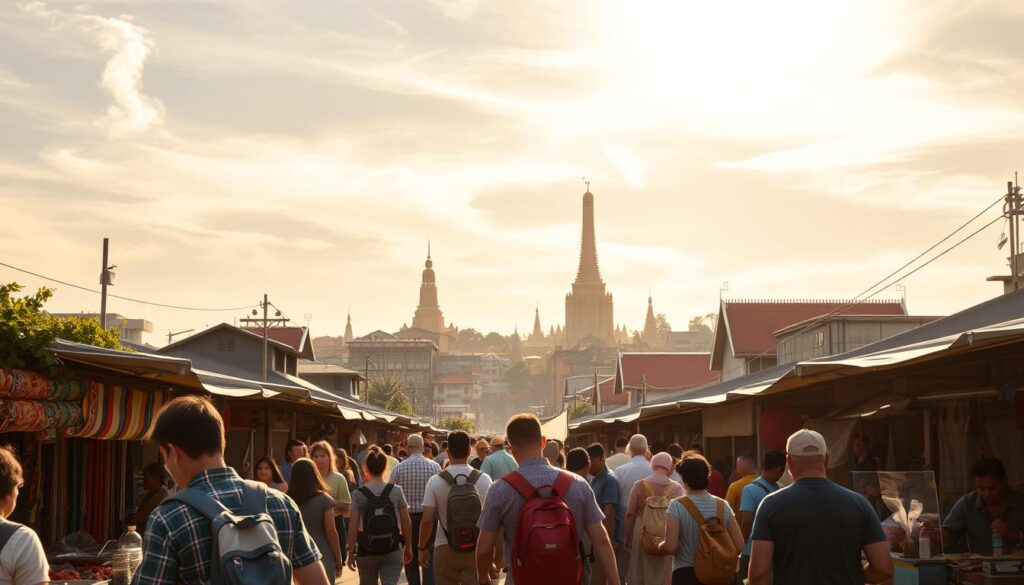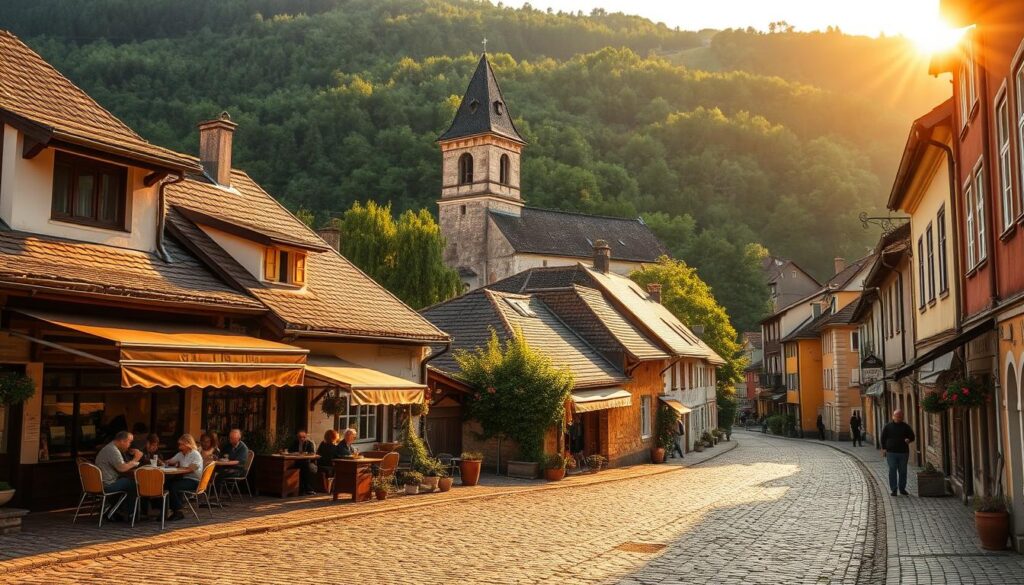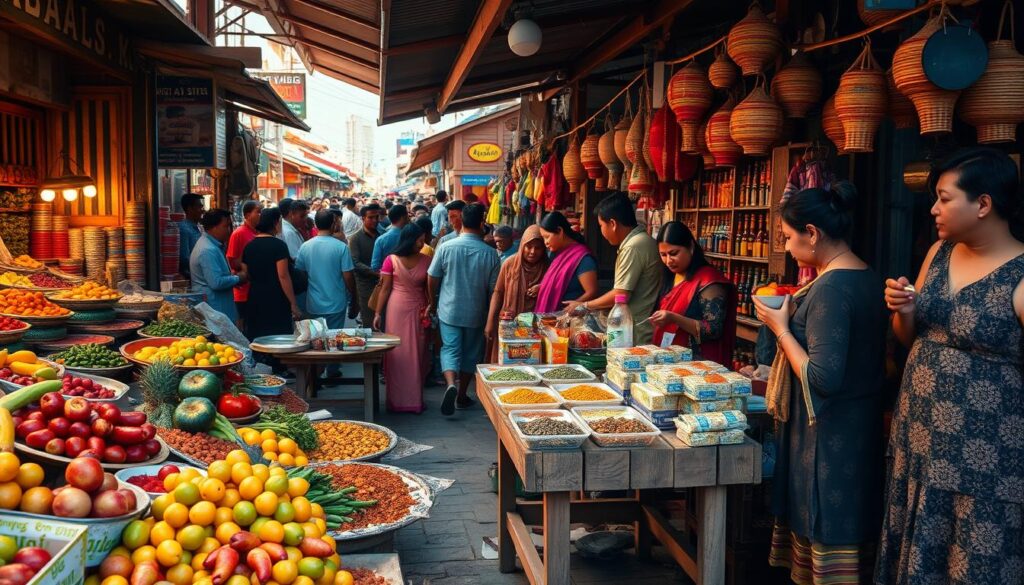I still remember my first solo trip a $30 overnight bus ride to a coastal town where I ate grilled squid from a street vendor and slept in a hostel run by a retired surfer. That trip taught me something magical: adventure doesn’t have to cost a fortune. Over the years, I’ve made it my mission to uncover spots where your dollar stretches further than you’d imagine, without skimping on culture or excitement.
This guide isn’t about surviving on crackers or skipping museums. It’s about smart discoveries—like finding family-run guesthouses hidden down cobblestone alleys or hiking trails that rival pricier destinations. Whether you’re craving spicy street food in Southeast Asia or medieval castles in Eastern Europe, I’ve curated 13+ countries where you can dive deep into local life while keeping your budget intact.
You’ll learn how to prioritize experiences that matter most, from sunset kayak tours to cooking classes with grandmothers in tucked-away villages. Let’s redefine what it means to travel rich—because the best memories often come with the smallest price tags.
Key Takeaways
- Affordable trips focus on cultural immersion over luxury amenities
- Street markets and local transit often provide authentic, budget-friendly experiences
- Eastern Europe and Southeast Asia offer exceptional value for accommodations
- Travel costs can stay low without sacrificing safety or comfort
- Seasonal timing impacts prices more than location in many destinations
- Free walking tours reveal city secrets better than expensive guided excursions
Introduction: My Journey in Budget Travel
My first real adventure began with a broken ATM in rural Cambodia. Stranded with $5 and a phrasebook, I discovered markets where $1 bought steaming bowls of kuy teav noodles and conversations with silk-weavers. That week taught me more about resourcefulness than any luxury resort ever could.
Breaking Through Financial Barriers
As a Thai passport holder, I’ve faced visa rejections and currency exchange rates that made Europe feel like a fantasy. But these limitations sparked creativity. I learned to stretch $15 daily by:
- Sleeping in monastery guesthouses ($3/night)
- Mastering local buses instead of tourist shuttles
- Trading English lessons for home-cooked meals
The Currency of Connection
Budget constraints became my superpower. When I couldn’t afford Parisian cafés, I shared street food feasts with Hanoi students. Instead of guided tours, I followed grandmothers through wet markets. These experiences taught me that:
- Authenticity thrives where prices are low
- Community connections outweigh fancy amenities
- Adventure scales to any wallet size
Now, when I plan trips, I seek destinations where my baht (or dollar) buys not just beds and meals, but stories. Because real travel magic happens when you’re resourceful, not rich.
Understanding Budget Travel and Smart Savings
My perspective on budget travel shifted during a rainy afternoon in Laos. While sheltering under a market stall’s tarp, I shared sticky rice with a vendor who later invited me to her village. That day cost less than $4 but gifted me a family recipe and a lifelong friendship. Smart travel isn’t about scarcity—it’s about resourceful abundance.

What It Means to Travel Cheap
Strategic spending turns limited funds into rich experiences. I prioritize memory-making moments over thread-count sheets. Here’s how I allocate my money:
| Category | Budget Focus | Luxury Alternative |
|---|---|---|
| Accommodation | Local guesthouses ($10/night) | Chain hotels ($80+) |
| Food | Street markets ($3/meal) | Tourist restaurants ($25/meal) |
| Activities | Free walking tours | Private guides ($50/hr) |
This approach lets me save money on basics to splurge where it counts—like a hot air balloon ride over Myanmar’s temples. Local transit becomes an adventure: overnight trains reveal landscapes missed by planes.
“The best souvenirs aren’t trinkets—they’re skills learned from locals.”
Understanding regional costs transforms budgets. In Vietnam, $1 buys phở from sidewalk chefs. In Albania, $5 covers museum entries. Flexibility unlocks hidden deals—traveling shoulder season often cuts accommodation costs by 40%.
Discovering the Cheapest Places to Travel
My budgeting strategy crystallized at a Balkan border crossing, watching seasoned backpackers barter for shared taxis while newbies overpaid for private transfers. That moment revealed a truth: daily costs hinge more on smart allocation than geography. Let’s unpack how to set realistic spending frameworks that unlock richer experiences.
Defining My Budget Expectations
Through trial and error, I’ve found $15-30 daily covers essentials in value-rich destinations. In Georgia, guesthouses cost $8/night, leaving $7 for khachapuri feasts and marshrutka rides. Turkey requires $30/day minimum $15 for pensions, $10 for kebabs, $5 for museum hops. Here’s how budgets shift across regions:
| Region | Daily Budget | Accommodation | Food | Activities |
|---|---|---|---|---|
| Caucasus | $15 | $5-8 | $4-6 | $3-5 |
| Balkans | $25 | $12-15 | $8-10 | $5-7 |
| Southeast Asia | $10-15 | $4-6 | $3-5 | $3-4 |
Three factors reshape these numbers: currency exchange rates (euro zones cost more), shoulder season timing (April in Sri Lanka slashes prices), and local transport networks (Vietnam’s buses vs. Croatia’s ferries). I prioritize countries where my dollar outpaces inflation—like Argentina’s blue dollar rate or Turkey’s lira fluctuations.
Value trumps absolute cost. Albania’s $40/day delivers castle stays and Ionian Sea views, while Paris demands $100+ for equivalent charm. I use cost-of-living indexes and hostel reviews to gauge real prices, always factoring in safety and cultural depth. This approach helped me uncover Romania’s $5 train passes and Nepal’s $10 trekking permits—proof that strategic planning turns modest funds into grand adventures.
Exploring Southeast Asia on a Budget
The scent of lemongrass and chili paste still takes me back to my first Chiang Mai night market, where $2 bought a feast of khao soi noodles and sticky mango rice. Southeast Asia remains my top recommendation for travelers seeking cultural depth without draining their savings.

Thailand: Where Flavors Meet Affordability
No country balances accessibility and excitement better than Thailand. Street food stalls serve pad thai for $1, while guesthouses in cities like Ayutthaya offer clean rooms at $12/night. My favorite hack? Taking third-class trains ($3 rides) between Bangkok and beach towns.
Indonesia & Vietnam: Untamed Value
Beyond Bali’s resorts, Indonesia’s 17,000 islands hide treasures. I once bartered with fishermen in Lombok for a $15 snorkeling trip to secret coves. Vietnam surprises with $1.50 phở bowls and $8 Halong Bay hostel beds. Both countries reward those who venture beyond guidebook places.
| Destination | Meal Cost | Accommodation | Top Experience |
|---|---|---|---|
| Thailand | $1-2 | $10-15 | Thai cooking classes ($8) |
| Vietnam | $1-1.50 | $7-12 | Halong Bay cruise ($25) |
| Indonesia | $1.50-3 | $9-14 | Komodo Island trek ($30) |
Smart transport choices stretch budgets further. Overnight buses ($10-15) connect major cities while saving on lodging. For authentic food experiences, I follow university students to their favorite street carts – better than any tourist restaurant.
Adventures in South America
I’ll never forget the afternoon I bartered for emeralds in Bogotá’s marketplace, my pockets stuffed with arepas de queso costing less than subway tokens back home. South America’s affordability surprised me most in Colombia and Peru two countries where street food fuels mountain treks and hostel friendships spark lifelong adventures.
Colombia’s Rhythm of Savings
Medellín taught me $1.50 buys more than lunch—it unlocks culture. The city’s Menu del Dia specials (think grilled meats, plantains, and fresh juice) fueled my afternoons exploring free salsa classes in Parque Lleras. Beyond cities, costs shrink further:
- $5/night hammock stays in Salento’s coffee farms
- Free hiking trails through Cocora Valley’s wax palms
- $3 shared jeep rides to rainbow-colored villages
Peru’s Ancient Bargains
My favorite adventure began with a $7 hostel in Cusco, where I partnered with Quechua guides to tackle the Andes. Peru blends affordability with grandeur:
| Experience | Cost | Tip |
|---|---|---|
| Machu Picchu trek | $200+ (tour) | Hike independently via Salkantay Trail ($50) |
| Lima food tour | $15 (group) | Eat at local picanterías ($3 meals) |
| Lake Titicaca homestay | $10/night | Trade English help for woven textiles |
Both countries prove South America competes with Southeast Asia’s value—especially when you embrace buses over planes and market stalls over restaurants. Whether summiting Andean mountains or mastering arepa recipes, every dollar here buys visceral connections.
Hidden Gems of Eastern Europe
I stumbled upon Albania’s Riviera by accident, trading crowded Greek islands for empty beaches where turquoise waters met $9 guesthouses. Eastern Europe’s undiscovered regions offer medieval grandeur and mountain adventures at prices that feel stolen from a 1990s guidebook.

Castles & Coastlines Without Crowds
Albania delivers Mediterranean magic on Balkan budgets. Berat’s white Ottoman houses cling to hillsides like sugar cubes, while Gjirokastër’s stone alleys hide $5 lamb stew feasts. My favorite discovery? Beachfront rooms along the Ionian Sea for less than a fast-food combo meal back home.
Romania’s Transylvania region transforms fairy tales into reality. Sibiu’s cobblestone squares and Brasov’s Gothic spires cost nothing to admire. For $15, I toured Dracula’s Castle at sunset – cheaper than most movie tickets – then slept in a 300-year-old guesthouse ($12).
| Country | Meal Cost | Accommodation | Top Experience |
|---|---|---|---|
| Albania | $5 | $9+ | Ottoman-era towns |
| Romania | $6 | $12+ | Transylvanian castles |
| Bosnia | $4 | $10+ | Stari Most bridge |
| Kosovo | $3.50 | $8+ | Medieval monasteries |
Where East Meets West Affordably
Bosnia’s Stari Most bridge arches over emerald waters in Mostar, where $4 buys ćevapi grilled meats from family-run shops. In Sarajevo, I sipped €1 Bosnian coffee beside bullet-scarred buildings – living history lessons cheaper than museum tickets.
Kosovo surprised me most. Pristina’s sleek cafés serve €1.25 macchiatos near 14th-century Serbian Orthodox monasteries. My €3.50 platter at a Peja steakhouse could feed two, proving this young country delivers mature flavors at student prices.
Immersing in Cultural and Culinary Experiences
My most vivid travel memories smell like sizzling garlic in Hanoi alleyways and taste like freshly ground coffee at a Sarajevo market stall. Food becomes your compass when exploring cultures—and your wallet stretches furthest when you follow the scent of local meal rituals.

Relishing Local Flavors on a Tight Budget
I’ve devoured life-changing dishes for less than the price of a soda. In Chiang Mai, $1.50 bought khao soi noodles swimming in coconut curry. Tbilisi’s underground bakeries sell cheese-stuffed khachapuri for $2—enough to fuel a day exploring cobblestone streets.
Three rules guide my culinary adventures:
- Follow office workers during lunch rushes
- Seat yourself where menus aren’t translated
- Learn to say “What’s good today?” in local dialects
This approach led me to Lima’s $3 ceviche counters and Istanbul’s simit sellers offering sesame rings for 50 cents. Budget dining isn’t about sacrifice—it’s discovering how people sustain traditions through affordable feasts.
| Destination | Signature Dish | Cost |
|---|---|---|
| Vietnam | Bánh mì | $1 |
| Nepal | Dal bhat | $1.50 |
| Sri Lanka | Kottu roti | $1.20 |
| Georgia | Khinkali | $0.50 each |
Markets become classrooms. I’ve learned to roll Turkish mantı dumplings from grandmothers in Bursa and sampled 12 Peruvian potato varieties at Cusco’s San Pedro Market. These experiences cost nothing beyond curiosity and a willingness to point at simmering pots.
“The best chefs aren’t in Michelin-starred kitchens—they’re stirring pots on sidewalk burners.”
Safety tips? Watch where locals dip their spoons. Busy stalls cycle ingredients quickly, and shared meal traditions often mean fresher food. With $5 daily, you’ll eat like royalty while collecting stories richer than any five-course dinner.
Mountain and Hiking Escapades
My boots crunched over Annapurna’s trails as I calculated costs—$6 hostel, $1.50 dal bhat—proving high-altitude dreams needn’t be high-cost. Nepal reshapes what’s possible for mountain enthusiasts, offering front-row seats to the world’s highest peaks without luxury price tags.
Where Thin Air Meets Thick Savings
This Himalayan nation delivers adventure on a shoestring. Skip guided tours—the Annapurna Circuit and Langtang Valley trails welcome solo hikers with teahouses ($3 beds) and steaming momo dumplings ($1). I once trekked 12 days to Everest Base Camp for less than most travelers spend on gear rentals.
Key routes reveal Nepal’s diversity:
- Upper Mustang’s desert cliffs (permits required)
- Ghorepani’s rhododendron forests (spring blooms)
- Rara Lake’s alpine solitude (off-season deals)
Local buses from Kathmandu to trailheads cost $6 vs. $150 flights. Meals become cheaper as you ascend—village kitchens compete for hikers with $1.50 thukpa noodle bowls. At night, mountains glow under starlight while your wallet stays happily full.
FAQ
What’s the best way to save money while exploring Southeast Asia?
I prioritize street food (like Bangkok’s
FAQ
What’s the best way to save money while exploring Southeast Asia?
I prioritize street food (like Bangkok’s $1 pad thai), overnight buses for transportation, and guesthouses in cities like Hanoi. Booking local tours directly instead of online also cuts costs!
Which South American cities offer affordable adventures?
Medellín, Colombia, has free walking tours and budget hostels. In Peru, Cusco provides cheap access to Machu Picchu hikes. Both cities have markets with $3–$5 meals and affordable public transit.
Are Eastern European destinations safe for solo travelers?
Absolutely! I felt welcomed in Albania’s Berat and Bosnia’s Sarajevo. Stick to well-reviewed hostels, use buses like FlixBus for cross-country trips, and carry local currency for small-town markets.
How do I enjoy local cuisine without overspending?
I skip touristy spots and follow locals to family-run *tavernas* or street stalls. In Romania, try *sarmale* (cabbage rolls) for under $2. Vietnam’s banh mi often costs less than a dollar!
Can I trek Nepal’s Himalayas on a tight budget?
Yes! Skip guided tours and hire local porters in Kathmandu. Teahouse treks in Annapurna cost $20–$30/day, including meals. Bring a reusable water bottle to avoid buying plastic.
What’s your top tip for finding cheap flights?
I use Google Flights’ price alerts and fly mid-week. For Europe, Wizz Air offers $50 one-way tickets. In Asia, AirAsia has deals like Bangkok to Bali for under $100!
Which destinations surprise travelers with their affordability?
Kosovo’s Prizren and Georgia’s Tbilisi! Meals cost $3–$5, hostels are $10/night, and hiking trails like the Accursed Mountains are free. Plus, local wine in Georgia is dirt cheap!
pad thai), overnight buses for transportation, and guesthouses in cities like Hanoi. Booking local tours directly instead of online also cuts costs!
Which South American cities offer affordable adventures?
Medellín, Colombia, has free walking tours and budget hostels. In Peru, Cusco provides cheap access to Machu Picchu hikes. Both cities have markets with – meals and affordable public transit.
Are Eastern European destinations safe for solo travelers?
Absolutely! I felt welcomed in Albania’s Berat and Bosnia’s Sarajevo. Stick to well-reviewed hostels, use buses like FlixBus for cross-country trips, and carry local currency for small-town markets.
How do I enjoy local cuisine without overspending?
I skip touristy spots and follow locals to family-run *tavernas* or street stalls. In Romania, try *sarmale* (cabbage rolls) for under . Vietnam’s banh mi often costs less than a dollar!
Can I trek Nepal’s Himalayas on a tight budget?
Yes! Skip guided tours and hire local porters in Kathmandu. Teahouse treks in Annapurna cost –/day, including meals. Bring a reusable water bottle to avoid buying plastic.
What’s your top tip for finding cheap flights?
I use Google Flights’ price alerts and fly mid-week. For Europe, Wizz Air offers one-way tickets. In Asia, AirAsia has deals like Bangkok to Bali for under 0!
Which destinations surprise travelers with their affordability?
Kosovo’s Prizren and Georgia’s Tbilisi! Meals cost –, hostels are /night, and hiking trails like the Accursed Mountains are free. Plus, local wine in Georgia is dirt cheap!

